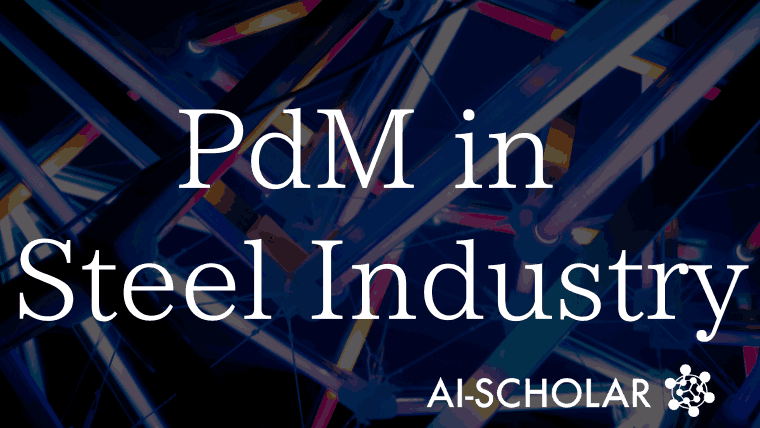
A Comprehensive Survey Of The Current Status And Challenges Of AI-Based Predictive Maintenance In The Steel Industry
3 main points
✔️ 219 studies on predictive maintenance (PdM) are analyzed to identify trends and research gaps in AI applications in the steel industry.
✔️ Research on anomaly detection and failure prediction using deep learning has progressed, particularly in blast furnaces and hot rolling mills.
✔️ Application in real-world environments and improvement of reproducibility are identified as future challenges, and a lack of implementation examples is an issue.
Artificial Intelligence Approaches for Predictive Maintenance in the Steel Industry: A Survey
written by Jakub Jakubowski, Natalia Wojak-Strzelecka, Rita P. Ribeiro, Sepideh Pashami, Szymon Bobek, Joao Gama, Grzegorz J Nalepa
(Submitted on 21 May 2024)
Comments: Preprint submitted to Engineering Applications of Artificial Intelligence
Subjects: Artificial Intelligence (cs.AI)
code:
The images used in this article are from the paper, the introductory slides, or were created based on them.
Summary
This paper summarizes the latest research trends in Predictive Maintenance (PdM) using Artificial Intelligence (AI) and comprehensively surveys its applications, especially in the steel industry. With the ongoing digitization of industry, AI-based facility management is gaining importance as part of Industry 4.0 (Fourth Industrial Revolution). The steel industry, in particular, uses large-scale facilities and operates under harsh environmental conditions, so the introduction of predictive maintenance can help prevent equipment breakdowns, reduce costs, and improve safety.
In this paper, we collected and analyzed 219 research papers on AI-enabled PdM and conducted a survey based on the following five research questions (RQs).
- What equipment and facilities are subject to predictive maintenance?
- What AI methods are used?
- What PdM approach is used?
- What data is being used?
- How do these methods affect real businesses?
This survey revealed that there is a particularly large number of studies on blast furnaces (Blast Furnace) and hot rolling mills (Hot Rolling Mill). In addition, the detection of abnormalities and life prediction using machine learning (ML) and deep learning (DL) are the mainstream, and methods using time series data and sensor data in particular have been widely researched. However, the application of these methods in actual production sites is still limited, indicating that there are further challenges to be overcome in order to put the research results to practical use.
Related Research
Predictive Maintenance (PdM) and Smart Industry
Three approaches to conventional equipment maintenance exist
- Reactive Maintenance
- A method in which equipment is repaired after it breaks down. Unexpected downtime occurs, affecting productivity.
- Preventive Maintenance
- Periodic inspections are performed in advance and parts are replaced on a fixed schedule. Maintenance can be planned, but there is a possibility of unnecessary parts replacement.
- Predictive Maintenance (PdM)
- A method that utilizes sensor data and AI to detect equipment deterioration and abnormalities in advance. Maintenance can be performed at the optimum timing to reduce costs and improve efficiency.
AI-Based PdM Methodology
PdM using AI technology uses the following techniques
- Anomaly Detection
- Detects deviations from normal behavior and detects signs of failure.
- Fault Diagnosis
- Identifies the causes of failure and analyzes which components are affected.
- Remaining Useful Life (RUL)
- Predicts how long the facility can operate normally for.
Various machine learning methods are applied to these tasks, including Neural Networks (NN), Support Vector Machines (SVM), Decision Trees, and Probabilistic Models.
Proposed Method
This paper organizes existing AI-based PdM research and systematically categorizes the latest developments in the steel industry. The main analytical methods are as follows
-
Conducting a literature review
- 219 articles from Scopus, Web of Science, IEEE Xplore, and ACM Digital Library.
- Organize relevant studies according to PRISMA (Preferred Reporting Items for Systematic Reviews and Meta-Analyses) guidelines.
-
Data Classification and Analysis
- Classification by equipment type (e.g., blast furnace, rolling mill, continuous casting machine, etc.).
- Classification of AI methods (NN, SVM, Decision Tree, Probabilistic Model, etc.).
- Characteristics of the data used (time series data, image data, sensor data, etc.).

Specifically, we systematically reviewed the relevant literature using the PRISMA guidelines to identify and categorize 219 studies (see Figure 3 ).
Result
Equipment to Which PdM is Applied

As shown in Figure 9, PdM is most frequently applied in the following facilities
- Blast Furnace
- Hot Rolling Mill
- Cold Rolling Mill
- Continuous Casting Machine
Status of Application of AI Methods
- Neural networks (NNs) are the most used. In particular, LSTMs and CNNs are most commonly used for time-series data.
- Support Vector Machines (SVM ) are also heavily used in anomaly detection tasks.
- Decision Tree and Random Forest are used for classification problems and anomaly detection.
Business Impact of Predictive Maintenance
- Reduction of down time: Equipment downtime was reduced by 20-50% with the introduction of PdM.
- Cost savings: Reduction of unnecessary parts replacement can save millions of dollars per year.
Conclusion
This paper details research trends in AI-based predictive maintenance in the steel industry. In particular, we found that PdM methods utilizing machine learning are being actively researched in blast furnaces and rolling mills. However, the following issues were also highlighted.
-
Practical Application Challenges
- Although high accuracy has been achieved in the research phase, its implementation in actual production environments is still limited.
- Data quality control and model interpretability (Explainability) are important.
-
Integration with new technologies
- Further optimization through integration with IoT, edge computing, and cloud AI is expected.
I found this paper to be a very informative study that provides a comprehensive overview of the current state of PdM in the steel industry. I look forward to its further development, as it is expected to significantly reduce costs and improve safety if it is introduced in actual production environments.
Categories related to this article



